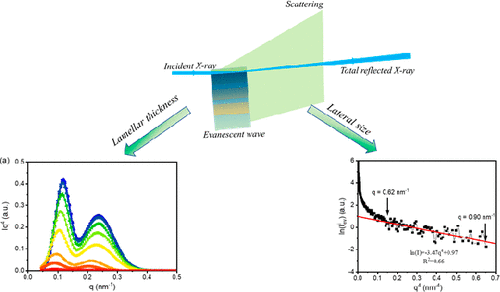当前位置:
X-MOL 学术
›
Macromolecules
›
论文详情
Our official English website, www.x-mol.net, welcomes your
feedback! (Note: you will need to create a separate account there.)
Microstructural Change of Poly(1-butene) during Crystallization, Phase Transition, and Melting Revealed by Synchrotron Small-Angle X-ray Scattering
Macromolecules ( IF 5.1 ) Pub Date : 2021-09-17 , DOI: 10.1021/acs.macromol.1c01472 Xiangyang Li 1 , Pujing Chen 1 , Min Xu 1 , Jianjun Ding 1 , Lin Chen 1 , Xian Zhang 1 , Xingyou Tian 1
Macromolecules ( IF 5.1 ) Pub Date : 2021-09-17 , DOI: 10.1021/acs.macromol.1c01472 Xiangyang Li 1 , Pujing Chen 1 , Min Xu 1 , Jianjun Ding 1 , Lin Chen 1 , Xian Zhang 1 , Xingyou Tian 1
Affiliation

|
For a long time, polymer lamellar crystals were hard to characterize accurately and comprehensively. The main reason is that the small-angle X-ray scattering (SAXS) mechanism of semicrystalline polymers has not been elucidated thoroughly. In recent years, we examined SAXS in semicrystalline polymers carefully, finding that SAXS in semicrystalline polymers probably is from a new physical mechanism, that is, evanescent wave-induced scattering. Based on the finding, a full set of new characterization methodologies for lamellar stack were proposed. In this study, to help more researchers to understand the new theory and methodologies, we introduce our new theory and methodologies systematically, with poly(1-butene) as an example. Results indicate that the new methods can extract effectively the structural information during the isothermal crystallization, phase transition, and melting of poly(1-butene), i.e., the lamellar thickness, long period, and lateral size. With the methods, it was found that the lamellar crystal as a whole can contract by 20% ± 4.5% in the lateral size and elongate by 12% along the chain direction during the phase transition, in agreement with the theoretical prediction. This conversely indicates the validation of the new theory. Initial evidence for the existence of the evanescent wave was also given. It is expected that, with this study, more researchers can better employ synchrotron SAXS to study polymer crystallization issues.
中文翻译:

同步加速器小角度 X 射线散射揭示聚(1-丁烯)在结晶、相变和熔化过程中的微观结构变化
长期以来,聚合物层状晶体难以准确、全面地表征。主要原因是半结晶聚合物的小角 X 射线散射 (SAXS) 机制尚未完全阐明。近年来,我们仔细研究了半结晶聚合物中的 SAXS,发现半结晶聚合物中的 SAXS 可能来自一种新的物理机制,即渐逝波诱导散射。基于这一发现,提出了一整套新的层状堆栈表征方法。在本研究中,为了帮助更多的研究人员理解新的理论和方法,我们系统地介绍了我们的新理论和方法,以聚(1-丁烯)为例。结果表明,新方法可以有效地提取聚(1-丁烯)等温结晶、相变和熔融过程中的结构信息,即层状厚度、长周期和横向尺寸。通过这些方法,发现在相变过程中,层状晶体整体可以横向收缩20%±4.5%,沿链方向伸长12%,与理论预测一致。这反过来表明新理论的有效性。还给出了渐逝波存在的初步证据。预计通过这项研究,更多的研究人员可以更好地利用同步加速器 SAXS 来研究聚合物结晶问题。通过这些方法,发现在相变过程中,层状晶体整体可以横向收缩20%±4.5%,沿链方向伸长12%,与理论预测一致。这反过来表明新理论的有效性。还给出了渐逝波存在的初步证据。预计通过这项研究,更多的研究人员可以更好地利用同步加速器 SAXS 来研究聚合物结晶问题。通过这些方法,发现在相变过程中,层状晶体整体可以横向收缩20%±4.5%,沿链方向伸长12%,与理论预测一致。这反过来表明新理论的有效性。还给出了渐逝波存在的初步证据。预计通过这项研究,更多的研究人员可以更好地利用同步加速器 SAXS 来研究聚合物结晶问题。还给出了渐逝波存在的初步证据。预计通过这项研究,更多的研究人员可以更好地利用同步加速器 SAXS 来研究聚合物结晶问题。还给出了渐逝波存在的初步证据。预计通过这项研究,更多的研究人员可以更好地利用同步加速器 SAXS 来研究聚合物结晶问题。
更新日期:2021-09-28
中文翻译:

同步加速器小角度 X 射线散射揭示聚(1-丁烯)在结晶、相变和熔化过程中的微观结构变化
长期以来,聚合物层状晶体难以准确、全面地表征。主要原因是半结晶聚合物的小角 X 射线散射 (SAXS) 机制尚未完全阐明。近年来,我们仔细研究了半结晶聚合物中的 SAXS,发现半结晶聚合物中的 SAXS 可能来自一种新的物理机制,即渐逝波诱导散射。基于这一发现,提出了一整套新的层状堆栈表征方法。在本研究中,为了帮助更多的研究人员理解新的理论和方法,我们系统地介绍了我们的新理论和方法,以聚(1-丁烯)为例。结果表明,新方法可以有效地提取聚(1-丁烯)等温结晶、相变和熔融过程中的结构信息,即层状厚度、长周期和横向尺寸。通过这些方法,发现在相变过程中,层状晶体整体可以横向收缩20%±4.5%,沿链方向伸长12%,与理论预测一致。这反过来表明新理论的有效性。还给出了渐逝波存在的初步证据。预计通过这项研究,更多的研究人员可以更好地利用同步加速器 SAXS 来研究聚合物结晶问题。通过这些方法,发现在相变过程中,层状晶体整体可以横向收缩20%±4.5%,沿链方向伸长12%,与理论预测一致。这反过来表明新理论的有效性。还给出了渐逝波存在的初步证据。预计通过这项研究,更多的研究人员可以更好地利用同步加速器 SAXS 来研究聚合物结晶问题。通过这些方法,发现在相变过程中,层状晶体整体可以横向收缩20%±4.5%,沿链方向伸长12%,与理论预测一致。这反过来表明新理论的有效性。还给出了渐逝波存在的初步证据。预计通过这项研究,更多的研究人员可以更好地利用同步加速器 SAXS 来研究聚合物结晶问题。还给出了渐逝波存在的初步证据。预计通过这项研究,更多的研究人员可以更好地利用同步加速器 SAXS 来研究聚合物结晶问题。还给出了渐逝波存在的初步证据。预计通过这项研究,更多的研究人员可以更好地利用同步加速器 SAXS 来研究聚合物结晶问题。










































 京公网安备 11010802027423号
京公网安备 11010802027423号